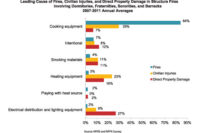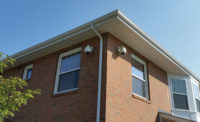As the nation continues to recover from the worst economic crisis in recent memory, security executives across America are dealing with the difficult consequences of the fallout. Among the greatest contributors to the harsh realities that so many companies face is the growing number of vacant properties, or “dark” locations. Every vacant property multiplies the risk to companies and communities by reducing value, increasing maintenance and repair costs, and providing a new location for crime-related activity.
By understanding the overall impact of a dark property, security executives stand to gain the knowledge and tools to reduce costs, ensure the safety of property caretakers, reduce crime and violence, protect the value of properties, and enable property owners to turn around and sell or lease them at a much faster rate. Additionally, by working with communities, they can help to improve the lives of local residents.
The State of Vacant Properties and Associated Costs
It is clear that in the last 18-24 months, the number of vacant properties has risen. According to reports and commentary from New York-based real estate research firm Reis, Inc.:
|
Even while record-breaking consumer spending occurred during the 2011 holiday season, sustained recovery of the retail sector is lagging. According to Jones Lang LaSalle's North America Year-End Retail Outlook in December 2011:
|
These vacant properties can bring a myriad of issues. One of them is damage from copper theft. In 2001, the U.S. Department of Energy called copper theft a $1-billion problem that was getting worse. According to an article in Claims Advisorpublished on September 15, 2011, copper prices have increased from approximately $0.77 per pound in 2003 to $4.00 per pound in 2011. Criminals redeem the stolen copper for quick cash from scrap yards before it is shipped to developing nations, such as China, India and South Korea, where it is in high demand.
A 2010 report from the National Association of Counties examined the average costs for dealing with:
|
With the mounting costs caused by these unsecured properties increasing, the time is ripe for security executives to take a proactive approach to dealing with dark locations.
Negative Impact on Companies and Communities
Covering windows and doors with wood is the most common first attempt to secure vacant properties against fire, crime and urban mining. However, because wood is penetrable, a number of cities across the country are banning that practice in favor of more effective means. According to customers of Vacant Property Specialists (VPS):
|
As an example, when Rite Aid, a national chain of 4,700 retail drug stores in North America, was forced to shutter a select number of lower-performing locations, the company found itself dealing with break-ins, costing several thousands of dollars in repairs, on each occasion. Rite Aid also elected to hire security guards at each dark store location to deter recurring damage. In addition, without a consistent and adequate reporting system across the various locations, it was extremely difficult to monitor for graffiti, illegal dumping and other negative activities that were occurring and can have a detrimental effect on properties.
While closing each location was wrought with challenges, perhaps one of the most unexpected challenges was how to “maintain” a now vacant property – including monitoring for water damage, power outages and upkeep of basic exterior maintenance like landscaping and snow removal, all of which becomes more difficult when the site is not visited daily
Customized Solutions and Best Practices
Taking into account all of these statistics and issues, what is the prescription for change? For Rite Aid, it was a truly customized solution that would mitigate a number of the issues facing its dark sites. The VPS “prescription” includes alarm installation and monitoring, steel window screens and impenetrable steel doors that are accessible only via pass code and will also open from the inside in case of emergency.
Starting first with 24 of Rite Aid’s dark stores primarily in California and Las Vegas, the VPS solution has enabled Rite Aid to remotely monitor vacant properties and cost effectively ensure that no further damage is done. For example, activated online, the alarm doesn’t require any energy expense, and it provides real-time alerts on a 24-hour basis, eliminating the need for security guards. The VPS alarm also allows brokers to continue safely entering and showing properties. Contractors, too, have the ability to keep working, because the steel window screens allow ventilation, light filtration and mold growth prevention, and the need for electricity during day time hours is eliminated. Additionally, an automatic, streamlined system has been established so that Rite Aid receives consistent, monthly on-site reports from all of its properties and can monitor for any issues requiring attention.
To date, Rite Aid has achieved cost savings, increased safety for property caretakers and the local communities, and better protected properties to meet compliance standards and maintain value.
Furthermore, in order to achieve the type of change outlined here, a greater understanding of the serious hidden costs and safety risks of vacant properties is vital. Looking ahead, we hope to help security executives think in a new way about the impact of vacant properties to companies and local communities, and inspire them to make a difference.
|
Securing the Structure |
|
Property owners and managers face a significant challenge when it comes to monitoring a building's daily traffic. It is not unusual for a high-rise office building in Manhattan, for example, to receive 1,700 to 2,000 visitors per day. Such is the case with Jim Weiss, vice president of asset management at Friedman Properties in Chicago. The company has a portfolio of 35 properties throughout the Chicago area, and it owns and manages more than 4 million square feet of space, including many of the city's most recognizable landmark buildings. With the city location comes typical thefts and minor crimes, including unwanted traffic, Weiss says. “In some of our properties people wander in off of the street, which means some theft does occur,” he says. “As part of that, we set up a master control center in one of our buildings. But we needed a new video surveillance system.” Weiss invested in a new surveillance system from Salient Systems that gives him the picture clarity he wants, with ease of replay and ease of operation. “It’s the ease of operation that has made it work for us,” he says. “We have been able to supply the police with information about break-ins to help them solve the crimes.” In one situation, he says, he discovered theft from a property’s loading dock. “Unfortunately, the theft occurred early morning when the cameras were not monitored as often,” he says. “When we figured out what happened we were able to view the entire incident on the camera, got the police involved and as a result, they were able to make an arrest.” For Bill Strother, director of corporate security for shopping center owner and developer Weingarten Realty, being able to react quickly to serious situations is key to keeping tenants safe. Strother’s responsibilities extend to more than 400 properties, the majority of which are large open-air complexes. The existing system of reporting such events – which could occur anywhere across the three time zones of the 23 US states in which Weingarten Realty operates – was paper-based, which was a problem. Sometimes, this paper trail of non-urgent incident reports, filed manually or passed up the chain of command by security team members, took far too long to reach him. “Information is power,” Strother says. “But if a security officer forgot to notify his supervisor, or the supervisor decided not to call me at 02:00 because, in his estimation, it wasn’t that severe and nothing needed to be done immediately, there were unnecessary delays.” Things came to a head when he was going through incident reports on his desk one day and learned about a significant event for the first time – two or three weeks after it had occurred. Those involved had dealt with it properly and thought the matter was closed, but Strother was aware that other actions could have been taken, if he had known about it sooner. He called Robert Burns, senior vice president, US Sales and Operations, at G4S, his main security provider. They agreed that the implementation of modern communications technology ought to speed up the transmission of information and provide the solution that Strother and other customers were looking for. But which device and system would be best suited for that purpose? Meetings took place, ideas were kicked around, devices were examined and tested but all were found wanting in one respect or another. When it realized the perfect solution was not available, G4S created Secure Trax, and Weingarten Realty agreed to be the test-bed for it. John Patton, G4S’s account manager and who oversaw the introduction of the project, explains: “So, what began as a digital reporting device slowly developed, stage by stage, into a mobile phone with GPS tracking added, as well as having a camera, e-mail functionality, text messaging, a panic alarm, time and attendance recording and even the ability to read bar codes as part of an advanced guard tour and facility inspection system, all built into an uncomplicated piece of equipment.” For three years, Weingarten Realty and G4S tested the technology in every situation, refining and improving it, before it was unveiled to the industry and began its roll-out to other customers. Strother’s need for the faster transfer of information has been translated into a system that far exceeds his initial demands and provides him with new risk management tools. Now, for example, officers can use the technology to capture images of reported problem areas – from pot holes and leaking sprinklers to abandoned cars – forwarding them from their PDAs via e-mail to Weingarten Realty’s property managers who then send the pictures on to contractors, speeding up response times and reducing the threat of litigation in some cases. One aspect of the technology is also great news for the employees who use the new devices. “We had a safety awareness meeting at one of our shopping centers and someone complained that they never saw the security officer who was supposed to be patrolling,” Strother recalls. “I know, of course, that retail people are busy multi-tasking and it’s easy for a security officer to pass by unnoticed. “So I took out my computer, pulled up the website, went to the previous day and showed them the tracking of that officer, which is recorded via the geo fencing and tracking capability. It showed he had covered that entire centre and he couldn’t have done it any better. The center’s management and its tenants were impressed that we had that capability and it restored their confidence in the security arrangements.” Confidence in security is what Peachtree Towers, a high-rise condo located in downtown Atlanta, can offer its tenants. It is the oldest condo in Atlanta, and many well-known individuals from the area live there, including state legislators who stay there when they are in town for work. The security officers, known as concierge staff, have to remain very confidential with who lives in the facility, but also be receptive to resident’s needs. They wear many different hats and do various duties for the building, including customer service (calling cabs, unlocking doors) and security detail. Unlike other high-rises, the facility is not open access and people must be buzzed in if they don’t have a key. There are also very strict procedures and restrictions for the security team and residents as to the buildings rules and regulations. For example, if a resident gets locked out of their living space, the security team can come unlock the door for them, but there is a fee (most places they will just come and unlock it for you, no questions asked) at Peachtree, the security team must ensure that this person is the owner and the fee helps to prevent unauthorized individuals from getting in. For years, Peachtree changed security providers because they were not able to find a complete match for their needs. Beyond access control and camera monitoring, they wanted a security provider who could also provide concierge services and a high-level of customer service for all residents. This meant the provider would have to hire the right security officers and they would need quality training to meet all of Peachtree’s needs. AlliedBarton Security Services was hired in 2007. The first step was recruiting security officers of such a high caliber who could perform all tasks for Peachtree. The client wanted individuals who could react quickly and professionally to all situations. The process included four different interviews to ensure they are the right fit for the Peachtree security management team. Each member of the security team is required to complete classroom training and on-site training by Glenn Topps, account manager, AlliedBarton, and Peachtree security management on everything from how to interact with residents and what to do if there is a power outage, water line break, elevator issues and more. The security officers provide much more than just standard security detail and go above and beyond the normal call of duty. |







